
Relaxation Room Ideas for Home
In this article we're discussing relaxation room ideas for home, offering tips on creating a peaceful retreat with soothing colors, comfortable furnishings, and calming decor.
A relaxation room at home can provide a sanctuary for peace and tranquility, but it's important to take into consideration several things for your maximum enjoyment.
Read on to discover how to design your own relaxing oasis.
What is a Relaxation Room?
A relaxation room is a personal sanctuary designed for peace and tranquility. This space helps you unwind and escape the stresses of daily life.
You can create a relaxation room in your home by dedicating a quiet area, such as a spare bedroom or a corner of your living room.
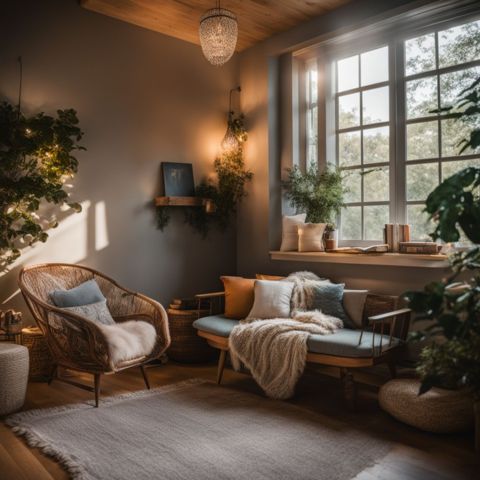
Fill it with comfy seating, like a plush armchair or a cozy sofa. Add soothing elements like soft lighting, calming colors, and nature-inspired decor.
Incorporate items that promote relaxation, such as scented candles, an essential oil diffuser, or a small water feature.
You can also include a spot for meditation or yoga, with a cushion or mat and some inspirational wall art.
The key to a successful relaxation room is to make it your own personal oasis.
Choose colors, textures, and decor that resonate with you and help you feel at ease. Keep the space clutter-free and minimalistic to promote a sense of calm.
You can also add personal touches, like family photos or meaningful mementos, to make the space feel more intimate and inviting.
Remember, your relaxation room is a place to unplug, recharge, and find inner peace, so design it in a way that speaks to your soul and helps you relax and rejuvenate.
Choosing Colors for a Relaxation Room
Choosing the right colors for your relaxation room can make a big difference in creating a calming atmosphere.
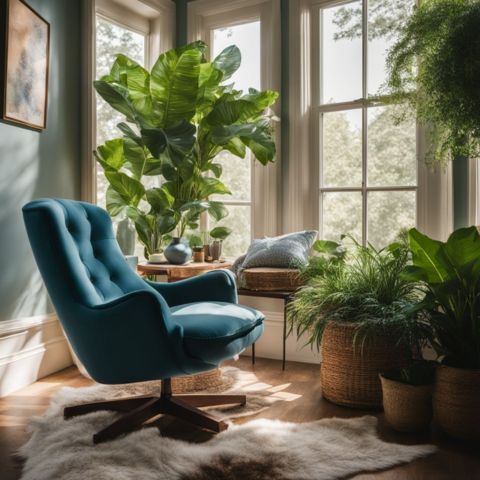
Opt for a tranquil color palette with neutral or cool tones like light blue, soft green, or muted lavender to promote relaxation and reduce stress.
Tranquil Color Palette
To create a peaceful ambiance in your relaxation room, choose a tranquil color palette.
Neutral tones like beige, ivory, and light gray promote a sense of calm and serenity.
These hues help establish a sanctuary-like atmosphere, allowing you to unwind and de-stress.
Consider incorporating soft, muted shades of blue, green, or lavender to add a soothing touch without overwhelming the space.
When selecting colors for your relaxation oasis, keep in mind the mood you want to evoke.
Cool tones like pale blues and greens are known for their calming effects, making them ideal for a space dedicated to relaxation and mindfulness.
If you prefer a warmer feel, opt for subdued shades of pale tan or faded yellow to prevent the room from feeling too sterile.
These warm hues can be balanced with cool accents to maintain a tranquil ambiance.
Opt for Neutral or Cool tones
Continuing with the tranquil color palette, opt for neutral or cool tones when designing your relaxation room at home.
Colors like light blue, sage green, and soft gray create a calming atmosphere that promotes relaxation and reduces stress.
These hues are easy on the eyes and evoke a sense of serenity, making them ideal for a space dedicated to unwinding and finding inner peace.
To prevent the room from feeling too cold or sterile, consider adding subtle hints of warmth with accents in pale tan, faded yellow, or light gold.
These touches of color can be incorporated through throw pillows, curtains, or artwork, adding visual interest without overpowering the soothing ambiance.
Consider Natural Light
Natural light plays a crucial role in creating a soothing ambiance for your relaxation room.
Large windows or skylights allow sunlight to flood the space, instantly uplifting your mood and reducing stress levels.
Position comfortable seating like a plush armchair or a cozy loveseat near the windows to bask in the warm glow of daylight while reading a book or practicing deep breathing exercises.
If your relaxation room lacks natural light, consider installing sheer curtains or adjustable blinds to filter and soften the artificial lighting.
Soft, diffused illumination from table lamps or floor lamps with warm-toned bulbs can mimic the calming effect of natural light, creating a tranquil environment conducive to unwinding and meditation.
In addition to soft, diffused illumination, consider the dynamic nature of natural light throughout the day.
Integrating lighting solutions that can adjust in brightness and color temperature to mimic natural daylight patterns might further enhance the room's calming effect.
Experiment with different lighting options until you find the perfect balance that promotes relaxation and enhances your overall well-being.
Designing a Relaxation Room
Designing a relaxation room involves adding natural elements, comfortable seating, inspiring wall art, essential oils, soft textures, negative space, and reflective surfaces to create a soothing atmosphere that promotes rest and rejuvenation.
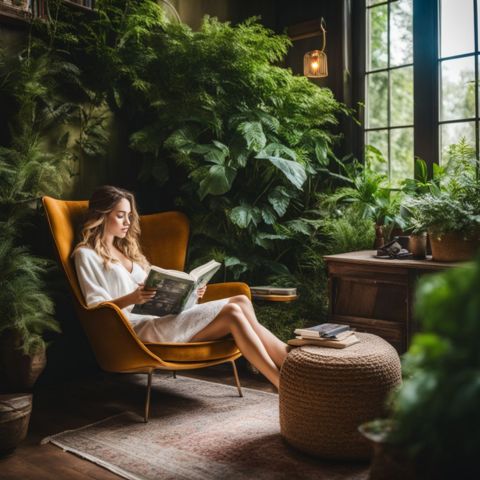
Read on to learn how to incorporate these elements into your own personal oasis at home or even your theater room.
Incorporate Natural Elements
Incorporating natural elements in your relaxation room can create a calming and serene atmosphere.
While houseplants like bamboo, snake plants, and peace lilies do add aesthetic value and can improve the subjective experience of indoor spaces, scientific evidence on their significant impact on air quality in typical home environments is limited.
A substantial number of plants would be required to have a noticeable effect on air purification, according to research. Nonetheless, incorporating these plants can contribute to a more natural and calming environment.
It's advisable to integrate plants as part of a broader strategy for improving air quality.
Natural materials such as rustic wood, stone, and woven decor enhance the relaxing ambiance of your meditation space.
Bring the outdoors in by adding potted plants, a small water fountain, or a terrarium to your relaxation room.
These natural elements connect you with nature and create a peaceful environment for meditation and stress reduction.
Comfortable Seating
Comfortable seating is essential for creating a relaxing atmosphere in your home retreat.
Beanbags provide a casual and cozy alternative to traditional meditation mats and cushions.
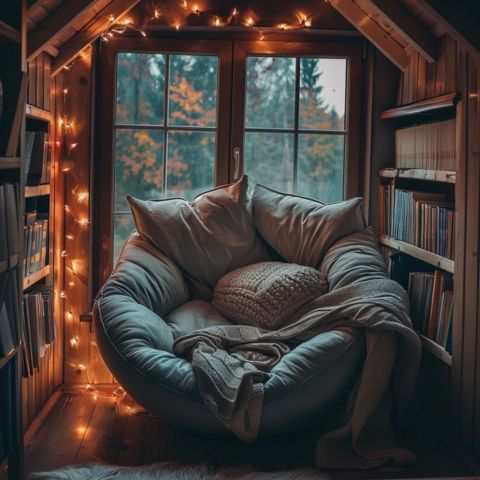
They mold to your body, allowing you to sink in and unwind. For a more structured option, consider a daybed or chaise lounge with plush pillows and soft blankets.
Repurposing a yurt or teepee as a dedicated relaxation space offers a unique and inviting setting.
Outfit the interior with floor rugs, poufs, and oversized cushions for comfortable seating during meditation or quiet reflection.
Inspiring Wall Art
After selecting comfortable seating, consider adding inspiring wall art to your relaxation room.
Hang framed photos of serene landscapes, such as a peaceful beach or a lush forest, to create a calming atmosphere.
You can also display motivational quotes or affirmations that resonate with you, helping to cultivate a positive mindset during your meditation or relaxation sessions.
Another option is to showcase personal artwork or DIY creations that hold special meaning to you.
This could include paintings, sketches, or even macramé wall hangings that you've crafted yourself.
Essential Oils
Incorporating high-quality, pure essential oils, such as lavender, chamomile, or eucalyptus, may enhance the ambiance of your relaxation room for some individuals.
It's crucial to select oils carefully, considering individual sensitivities and the potential for allergic reactions, as responses to scents can significantly vary.
Begin with a modest amount to ensure the fragrances are comforting and not overwhelming, and always prioritize good ventilation when diffusing essential oils.
Selecting reputable brands and avoiding oils with synthetic additives can further ensure a positive and safe experience.
Aromatherapy, involving the use of essential oils, is believed to offer health benefits such as reduced anxiety and improved sleep quality for some individuals, though experiences and scientific evidence vary.
While some studies suggest that essential oils like lavender, chamomile, or eucalyptus can have positive effects on anxiety, sleep quality, and overall well-being, responses can vary greatly among individuals.
It's important to use essential oils cautiously, considering potential allergies or sensitivities.
Always ensure good ventilation when diffusing oils and consider consulting a healthcare provider, especially for those with respiratory issues or pregnant women.
Soft Textures
Soft, cozy textures are essential for creating a soothing and inviting relaxation room at home.
Incorporate plush cushions, fluffy blankets, and thick, luxurious rugs to make the space feel warm and comfortable.
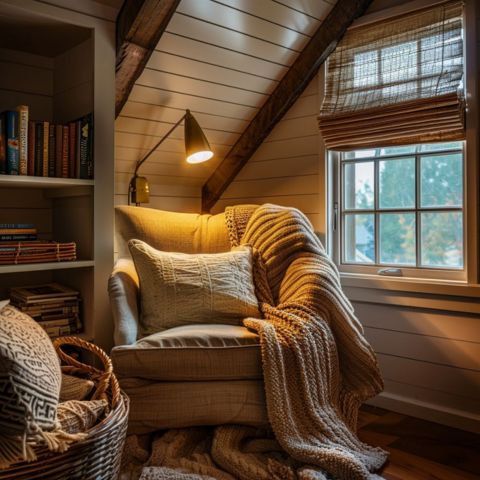
These snuggly elements not only provide physical comfort but also contribute to a calming atmosphere that encourages relaxation and stress relief.
When selecting textiles for your relaxation room, opt for natural materials like cotton, linen, or wool, which are gentle on the skin and breathable.
These fabrics create a sense of harmony with the environment and promote a feeling of tranquility.
Negative Space
Seamlessly transitioning from soft textures, incorporating negative space is equally crucial in designing a relaxing room.
Empty areas between furniture and decor elements create a sense of openness and tranquility.
Resist the urge to fill every nook and cranny, as cluttered spaces can increase stress levels and hinder relaxation.
Strategically placed blank walls, clear floor space, and unadorned surfaces allow the mind to rest and breathe.
This minimalistic approach promotes a serene atmosphere, enabling you to fully unwind and recharge in your personal sanctuary.
Reflective Surfaces
Transitioning from negative space, reflective surfaces can elevate the ambiance of a relaxation room.
Mirrors and other glossy materials bounce light around, making the area feel more spacious and open.
They also bring the outdoors in by reflecting views of nature, creating a deeper connection with the external environment.
When used thoughtfully, these shimmering elements add a touch of luxury and elegance to the overall aesthetic.
Place them strategically to establish visual symmetry and draw the eye to key focal points.
Creating a Zen Environment
Creating a Zen Environment is an important aspect of designing a relaxation room.
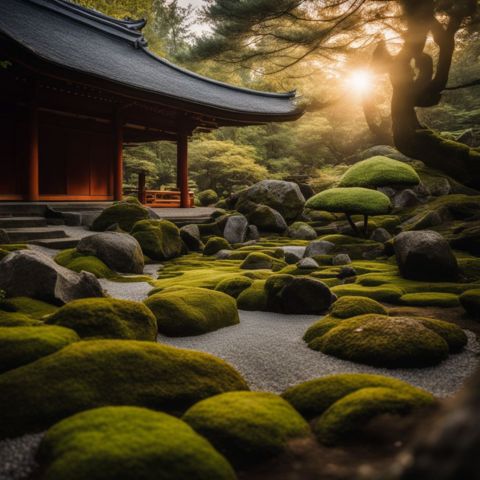
A small indoor fountain or nature-inspired decor might contribute to a peaceful ambiance in your relaxation room, offering a soothing sound that many find conducive to relaxation.
However, preferences for such auditory elements vary, and the maintenance required for water features should also be considered.
It's important to choose features that match your personal relaxation needs and maintenance capabilities.
Install a Water Feature
Installing a water feature is a great way to create a calming and serene atmosphere in your relaxation room at home.
A small indoor fountain or a miniature pond can add a soothing sound of trickling water, promoting mindfulness and harmony with nature.
The gentle flow of water provides a visual and auditory focal point for meditation, helping you relax and unwind.
Choose a water feature that complements your room's décor and place it in a prominent spot where you can enjoy its tranquil benefits.
When selecting a water feature for your relaxation space, consider the size of your room and the level of sound you prefer.
A tabletop fountain might be perfect for a smaller area, while a larger floor fountain can make a bold statement in a more spacious room.
Use Nature-Inspired Decor
Bring the outdoors in by decorating your relaxation room with nature-inspired elements.
Hanging plants, such as pothos or spider plants, can purify the air and create a calming atmosphere.
Choose decorative wood wall pieces, like a carved mandala or a rustic wooden sign with an inspirational quote, to add a natural touch to your space.
Incorporate earth tones and natural materials to create a serene environment.
Opt for a soft green paint color or wallpaper with a leaf pattern to evoke a sense of tranquility.
Place a jute or sisal rug on the floor to add texture and warmth.
Soft Lighting
Soft lighting is an essential element in creating a relaxing and calming atmosphere in your home meditation space.
Dim lamps, candles, or string lights can help reduce stress and promote relaxation.
During the day, take advantage of natural light by opening curtains or blinds to let in a gentle glow.
In the evening, create a soothing ambiance with a warm and inviting lighting scheme using table lamps, floor lamps, or wall sconces with soft, diffused light.
Choose light bulbs with a warm color temperature around 2700-3000K to mimic the warm glow of candlelight.
Install dimmer switches to easily adjust the brightness level according to your mood and preference.
Avoid harsh overhead lighting that can be too stimulating and instead opt for multiple light sources placed at different levels to create a balanced and harmonious lighting environment.
Display Family Photos
Displaying family photos in your relaxation room can create a personalized and meaningful environment.
Hanging pictures of loved ones on the walls fosters a sense of comfort, connection, and gratitude.
Choose frames that complement your room's color palette and arrange them in a pleasing manner.
Consider using a digital photo frame to showcase a rotating selection of favorite memories.
Surrounding yourself with images of cherished moments and special people can evoke positive emotions and remind you of what matters most.
Whether you're practicing yoga, meditating, or simply taking a break, family photos can inspire a calming and uplifting atmosphere.
Bring the Outdoors In
Another way to create a serene and natural atmosphere in your relaxation room is by bringing elements of the outdoors inside.
Incorporating potted plants like peace lilies or bamboo into your space may not only enhance the aesthetic appeal but also can contribute to a sense of tranquility.
While some plants have been noted for their air-purifying abilities, it's important to have a significant number of plants to noticeably improve indoor air quality, according to studies.
Consider placing a vase of fresh flowers or branches on a side table to bring a touch of nature into the space.
You can also incorporate natural materials like wood, stone, or woven baskets to create a cohesive, organic feel.
These natural elements not only add visual interest but also help to create a calming and grounding environment that encourages relaxation and stress relief.
Personalizing Your Relaxation Room
To truly make your relaxation room your own, add personal touches that bring you joy and peace.
Get creative with DIY projects like a miniature zen garden or handmade wind chimes that reflect your style.
DIY Zen Garden
A DIY Zen garden lets you add a personal touch to your meditation room. It allows you to infuse your own creative energy into the space.
Here are some tips for making your own Zen garden:
- Choose a container: Find a shallow, wide container like a serving tray or baking dish. Wood, ceramic, or glass work well.
- Add sand: Pour in fine, light-colored sand as the base. Avoid dark sand as it can look dirty. Rake designs into the sand for a calming effect.
- Include rocks: Place a few smooth stones or pebbles on top. Odd numbers often look best. Arrange them in a pleasing pattern.
- Incorporate plants: A small succulent or air plant adds a nice natural touch. Keep the design simple and uncluttered.
- Personalize it: Include a meaningful object like a crystal or memento to make it your own. This creates an emotional connection to the space.
- Add a mini rake: A small wooden rake lets you draw designs in the sand. Creating swirls and lines is soothing and meditative.
- Keep it simple: Don't overdo the elements. The beauty is in the simplicity and clean lines. Less is more with Zen gardens.
DIY Wind Chimes
DIY wind chimes add a unique and personalized touch to a relaxation room. Making your own wind chimes allows for a creative and customized decor element.
Here are some ideas for crafting DIY wind chimes:
- Choose materials like metal tubes, glass beads, driftwood, or seashells
- Cut varying lengths of fishing line or strong thread to hang the chimes
- Drill holes in the materials to thread the lines through
- Attach the lines to a sturdy base like a wooden hoop or metal ring
- Experiment with different arrangements and sounds until you find a pleasing combination
- Hang your finished wind chimes near a window or door for maximum effect
- Consider adding beads, feathers, or other decorative elements for visual interest
- Use recycled materials like old keys or silverware for an eco-friendly option
- Paint or decorate the chimes to match your relaxation room's color scheme
- Place your wind chimes in a spot where they will catch a gentle breeze
DIY Artwork
Creating your own artwork is a great way to personalize your relaxation room. It allows you to infuse the space with your unique energy and creativity.
Consider these ideas for DIY artwork in your zen den:
- Paint a calming landscape or abstract scene using soothing colors like blues, greens, and purples
- Create a mixed media collage incorporating natural elements such as pressed flowers, feathers, and leaves
- Make a tapestry or wall hanging using soft, textured fabrics in muted tones
- Design a series of inspirational quote prints or affirmation cards to display
- Craft a mobile or wind chime using driftwood, seashells, and sea glass
- Assemble a gallery wall of framed photos capturing peaceful moments or cherished memories
By surrounding yourself with meaningful art pieces you've made yourself, your relaxation room will feel even more special and restorative.
Displaying your DIY creations can also serve as a visual reminder of your intention to find tranquility and balance in the space.
Next, let's explore how adding personal touches can further enhance the calming ambiance of your relaxation room.
Personal Touches
Personalizing your relaxation room with cherished items can deepen your sense of tranquility and belonging.
Display family photos, travel souvenirs, or handmade art to infuse the space with meaningful memories.
These reminders of happy times and loved ones promote a calming atmosphere that encourages relaxation.
Floating shelves offer a stylish way to showcase your personal touches without overwhelming the room.
Arrange a few carefully chosen pieces on the shelves, such as a serene Buddha statue, a scented candle, or a small potted plant.
FAQs
What are some relaxation room ideas that can help with insomnia?
Creating a minimalist space for meditation and practicing zazen can help calm the mind before sleep. Soundproofing the room also reduces noise disturbances that may cause insomnia.
How can I create a relaxing environment in my home gym or workout space?
Incorporate soothing elements like soft lighting, plants, and comfortable seating to transform your workout area into a relaxing headspace for post-exercise meditation and unwinding.
What apps are helpful for creating a relaxing atmosphere in my home?
Popular meditation apps, such as Breethe, offer guided sessions, calming music and nature sounds to enhance the ambiance of your relaxation room. Many are available for both iPhone and Android.
What decorative elements work well in a relaxation room?
Minimalism is key - keep decor simple and uncluttered. Soft fabrics like plush pillows, fluffy rugs, and sheer valances create a cozy and inviting atmosphere conducive to relaxation.
Conclusion
We hope you've found some relaxation room ideas for home that you're excited about using.
Too often we go through life without taking the time to slow down, clear our minds, and fully relax.
Your relaxation room awaits, ready to soothe your mind and refresh your spirit.
Now, go build it.
Disclaimer:
We do not provide medical advice. The content of this article, including text, graphics, and other material, is for informational purposes only. It is not intended to be a substitute for professional medical advice, diagnosis, or treatment. Always seek the advice of your physician or other qualified health provider with any questions you may have regarding a health condition. Never disregard professional medical advice or delay in seeking it because of something you have read in this article or on our website.
